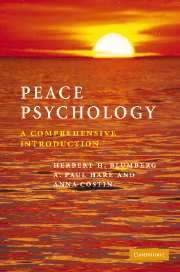Book contents
1 - Trends in peace psychology
Published online by Cambridge University Press: 05 June 2012
Summary
One important cause to which several thousand psychological publications have been devoted is the pursuit of worldwide peace. For the period up to the end of the Cold War, particularly in the 1980s, Blumberg and French (1992) documented about 1,500 publications in this and closely related areas; and – if one uses a rather wide definition of peace psychology – Kramer and Moyer (1991) and Müller-Brettel (1993a), between them, documented a further like amount.
The present discussion is intended, first, to give a broad picture of the field – rather like a town plan that puts locations in perspective but may show little about the architecture of the buildings and the feelings of the people living there. This ‘broad picture’ includes delineation of the contents and growth of the area, and consideration of taxonomic schemes for the relevant research. Following that, however, is an indication of some of the major developments and themes included in the research.
Readers who would like to ‘zoom in’ slightly on the ‘town plan’ should refer to the earlier section ‘The scope, structure and content of this book’, to learn how this book's topics are clustered. Those wanting information on a fairly specific topic might, of course, also consult the index.
Arguably the two events occurring between 1980 and 2005 that have had the greatest (direct or indirect) impact on Western foreign policy – and possibly on psychological aspects of peace and international conflict resolution – have been the end of the Cold War (and of the Soviet Union) and the terrorist attacks of 11 September 2001 (as regards the latter, see Roy, 2002).
- Type
- Chapter
- Information
- Peace PsychologyA Comprehensive Introduction, pp. 3 - 16Publisher: Cambridge University PressPrint publication year: 2006
- 4
- Cited by

